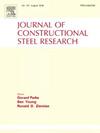Equivalent loading protocols for steel plate shear wall considering seismic action characteristics
IF 4
2区 工程技术
Q1 CONSTRUCTION & BUILDING TECHNOLOGY
引用次数: 0
Abstract
Determining the loading protocol in the quasi-static tests of the steel plate shear wall (SPSW) plays an important role in evaluating the seismic performance, which should effectively reflect the real responses of SPSW subjected to the action of earthquakes. Therefore, equivalent loading protocols for SPSW are developed, which can consider both far-field and near-fault seismic action characteristics. Firstly, the prototype structure systems of SPSW are designed, and the ground motions are selected for nonlinear time-history analysis through OpenSees. Then, the load parameters of the critical story are counted based on the rain-flow counting method. Finally, the rationality of the proposed loading protocols is validated by comparing them with the results of time-history analysis. The performance of SPSW under the proposed and existing loading protocols is also compared. The results show that the proposed far-field loading protocol covers a more comprehensive range of inter-story drift angles (ISDA), which is conducive to evaluating the performance of SPSW with better ductility. The proposed near-fault loading protocols consider different seismic intensities and have better applicability. Both the proposed far-field and near-fault loading protocols can well capture the cyclic distributions of damage in the range of different ISDAs, and can represent the actual seismic action to test the seismic performance of SPSW. There is little difference in the performance of SPSWs under the proposed far-field and existing far-field loading protocols. The proposed near-fault loading protocol compensates for the lack of consideration of near-fault ground motion characteristics in the existing loading protocols.
考虑地震作用特性的钢板剪力墙等效加载规程
本文章由计算机程序翻译,如有差异,请以英文原文为准。
求助全文
约1分钟内获得全文
求助全文
来源期刊

Journal of Constructional Steel Research
工程技术-工程:土木
CiteScore
7.90
自引率
19.50%
发文量
550
审稿时长
46 days
期刊介绍:
The Journal of Constructional Steel Research provides an international forum for the presentation and discussion of the latest developments in structural steel research and their applications. It is aimed not only at researchers but also at those likely to be most affected by research results, i.e. designers and fabricators. Original papers of a high standard dealing with all aspects of steel research including theoretical and experimental research on elements, assemblages, connection and material properties are considered for publication.
 求助内容:
求助内容: 应助结果提醒方式:
应助结果提醒方式:


